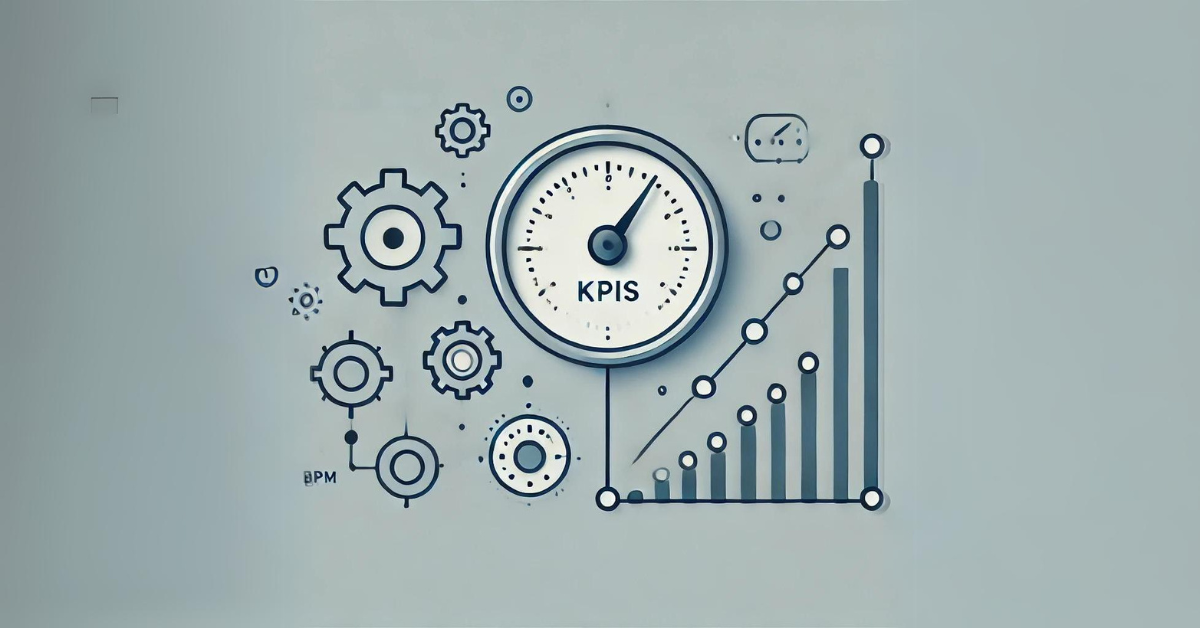
Exploring the World of As-Is Process Modeling with BPMN
Welcome to a thorough examination of As-Is process modeling using BPMN, an important tool for analyzing and improving business operations.
Understanding As-Is Modeling and BPMN
At the heart of any business transformation lies the As-Is process model, a visual and factual blueprint of current operations. It’s like a snapshot that captures the essence of business workflows, serving as a starting point for any further process improvement.
BPMN, or Business Process Model and Notation, is widely recognized language for describing business processes. Far from being just a set of symbols, it’s a comprehensive language developed for the sole purpose of making business operations transparent and understandable to all stakeholders.
Tracing the Origins of BPMN and Its Impact on Business Administration
The inception of Business Process Model and Notation (BPMN) was a pivotal moment in the evolution of business process management. Let’s examine the development of BPMN and the influential works that have influenced its use in the field of business administration.
Historical Backdrop of BPMN
BPMN emerged from the need to create a standardized method for representing business processes that could be easily understood and implemented across various business domains. Prior to BPMN, there was a proliferation of process modeling notations, which often led to confusion and inconsistency.
In response, the Business Process Management Initiative (BPMI) developed BPMN in the early 2000s. It was intended to provide a notation that was readily understandable by all business users, from the business analysts who create the initial drafts of the processes, to the technical developers responsible for implementing the technology, and finally, to the business people who will manage and monitor those processes.
The Foundational Authors and Their Influential Works
Several authors have been instrumental in advancing the concepts underpinning BPMN and its relevance to business administration:
Dr. Michael Havey: In his influential book ‘Essential Business Process Modeling,’ Havey detailed the intricacies of BPMN and how it applies to enterprise application integration. His work helped solidify the understanding of BPMN’s place in system design and process improvement.
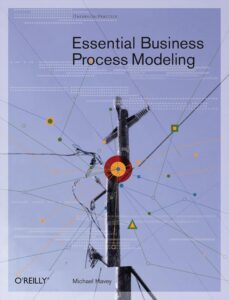
Bruce Silver: Silver’s book ‘BPMN Method and Style’ went a step further, offering readers a methodology to apply BPMN effectively in practice. Silver’s approach has been highly regarded for its practicality and focus on standards-based methodology.
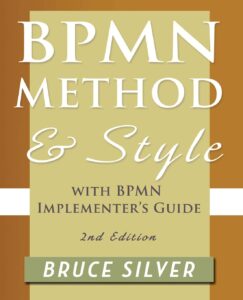
Prof. Dr. Wil van der Aalst: Often referred to as the godfather of process mining, van der Aalst has contributed to the field with his book ‘Process Mining: Data Science in Action.’ Though not exclusively about BPMN, his work has influenced the domain of process modeling and the way BPMN is applied in analyzing and improving business processes.

Evolution and Adoption
BPMN has since evolved, with its latest version (as of my last update) being BPMN 2.0, which includes enhancements that allow for executable process models. This development expanded BPMN’s utility beyond mere documentation to becoming an integral part of business process management suites (BPMS) that automate and monitor processes.
Distinguishing Process Modeling from Process Mapping
In the field of business process management, terms like ‘modeling’ and ‘mapping’ are often used interchangeably, yet they serve different purposes. Let’s clarify these concepts to understand how they each play a vital role in BPM.
What is Process Mapping?
Process mapping is the initial step in any BPM project. It is akin to charting a map for a journey; it provides a basic visual representation of a business process. The map is a straightforward diagram that outlines the sequence of tasks or activities, often without delving into the granular details. It is descriptive in nature, highlighting the ‘what’ and ‘who’ of a process.
Key aspects of process mapping:
- Simplifies understanding by showing the flow of tasks.
- Identifies who performs each step.
- Establishes the sequence and interaction of tasks.
- Is generally static, representing the process at a specific point in time.
What is Process Modeling?
Process modeling goes several steps further by not just outlining the process, but also providing a detailed framework that captures the dynamic nature of business operations. It uses a set of standardized notations, such as BPMN, to offer a more profound, analytical view of the process. Modeling doesn’t just describe; it simulates and analyzes the workflow, often using sophisticated software tools.
Key aspects of process modeling:
- Explores the ‘how’ of a process, in addition to the ‘what’ and ‘who’.
- Includes decision points, rules, events, and the flow of data.
- Is dynamic, allowing for simulation and analysis of different scenarios.
- Facilitates communication between various stakeholders through standardized notations.
The Interplay Between Mapping and Modeling
Mapping is like creating an outline or rough draft, whereas modeling involves creating a more detailed and specific plan. Mapping provides the groundwork for modeling; one cannot model effectively without a clear map. Conversely, modeling expands upon the map to create a comprehensive and actionable representation of a business process.
In essence, mapping is about capturing the current state in a simplified form, whereas modeling is about exploring the details and potential future states of the process.
The Abstraction Principle in BPMN for Modeling and Mapping
BPMN, standing as a versatile language for both process modeling and mapping, accommodates varying degrees of detail. This adaptability is rooted in the principle of abstraction, which allows practitioners to tailor the depth of process depiction according to the project’s needs.
Abstraction in Process Mapping
When mapping processes with BPMN, the abstraction principle helps to distill complex processes down to their most fundamental elements. This high-level view is not bogged down by the minutiae but focuses on capturing the essential flow and sequence of activities.
Key points for abstraction in mapping:
- It focuses on the broader picture, emphasizing the flow and key activities.
- Details like decision logic, intermediate events, and exception handling are often omitted to maintain clarity.
- The abstraction allows for quick comprehension and is particularly useful for stakeholders who need an overview without the complexity.
Abstraction in Process Modeling
In contrast, when modeling with BPMN, while you still can maintain a certain level of abstraction, you have the option to delve deeper. You can represent the nuances of the process, including the decision logic, the timing of events, and the synchronicity of tasks. This detailed view is more analytical, providing the insights needed for process optimization and simulation.
Key points for abstraction in modeling:
- It offers a fine-grained representation, suitable for analysis and optimization.
- The degree of detail can be adjusted according to the purpose of the model, whether for operational, tactical, or strategic analysis.
- While more complex, it enables stakeholders to identify and understand the impacts of process changes before implementation.
Balancing Abstraction in BPMN
BPMN provides a spectrum of abstraction that serves both mapping and modeling. The key is to balance the amount of detail against the objectives of the business process study.
For mapping, abstraction means simplifying the process to its core components to achieve broad understanding.
For modeling, it means incorporating enough detail to analyze, simulate, and improve processes while avoiding unnecessary complexity that can obscure the process’s objectives.
The level of abstraction chosen will affect how the processes are understood, communicated, and eventually, how well they can be managed and improved upon.
Bringing It All Together
BPMN’s true power lies in its flexibility to cater to both high-level overviews and detailed analysis. Whether you’re outlining a basic process map or developing an complex process model, BPMN’s tools and symbols can be applied with the precision required by the task at hand. Our BPM Fast Mode Courses are designed to help you navigate these nuances, teaching you when and how to apply different levels of abstraction for maximum impact in your BPM initiatives.
BPMN: The Universal Business Workflow Model Language
Introducing BPMN
Business Process Model and Notation (BPMN) is the globally accepted standard for capturing and designing business processes. Its strength lies in its ability to provide a uniform language understandable by all business stakeholders, from the technical architect to the executive manager.
Characteristics of BPMN
Orientation: Flow-Based and Intuitive
BPMN is inherently flow-based, representing processes in a sequential manner that mirrors the natural flow of tasks and decisions in a business. This orientation is intuitive, mirroring the chronological order of business activities, making it easy for anyone to follow and understand.
Verbal and Non-Verbal Communication
BPMN combines both verbal and non-verbal elements. Its textual components allow for the annotation and description of tasks and events, while its non-verbal notation – comprising shapes, lines, and icons – conveys the process flow and type of tasks or events visually. This duality ensures that the process is clearly communicated at every level, bridging the gap between different stakeholders.
Non-Interruption and Start-to-End Principles
Every BPMN diagram is built on the principle of non-interruption, depicting a continuous flow that moves from a clear start to a defined end. This represents real-world processes that are designed to operate without unnecessary pauses or interruptions, ensuring efficiency and flow continuity.
Human and Machine Perspectives
BPMN cares out both human and machine perspectives. It recognizes that modern business processes are often a symphony of human tasks and automated systems working in tandem. BPMN diagrams can thus illustrate where human interactions occur and how they integrate with automated processes, providing a holistic view of the business workflow.
BPMN vs. Traditional Flowcharts
While traditional flowcharts have been used for decades to represent procedures and workflows, BPMN offers a richer and more specialized language specifically designed for business processes. The key differences are:
Standardization: BPMN is standardized, meaning that its symbols and usage rules are consistent across all organizations.
Expressiveness: BPMN provides a more comprehensive set of symbols that can capture complex process semantics like exception handling, events, and messaging which are beyond the scope of traditional flowcharts.
Interoperability: BPMN diagrams can be understood by BPM systems, enabling not just visualization but also execution and simulation of business processes.
Communication: BPMN is designed to be clear to all stakeholders, facilitating communication between technical and non-technical users.
Pools and Lanes: The main difference between BPMN vesus Flowchart
BPMN clearly assigns responsibility for completing tasks, while flowcharts do not. This is accomplished through the use of BPMN’s Pool and Swimlane concepts, or simpler Lanes.
BPMN as the Keystone of Process Visualization
BPMN’s structure and richness make it an indispensable tool for modern businesses. It provides a clear, standardized, and comprehensive way to represent complex business workflows. By understanding and utilizing BPMN, professionals can ensure that processes are communicated effectively, enabling better design, analysis, and improvement of business operations.
Essential BPMN Elements for As-Is Modeling
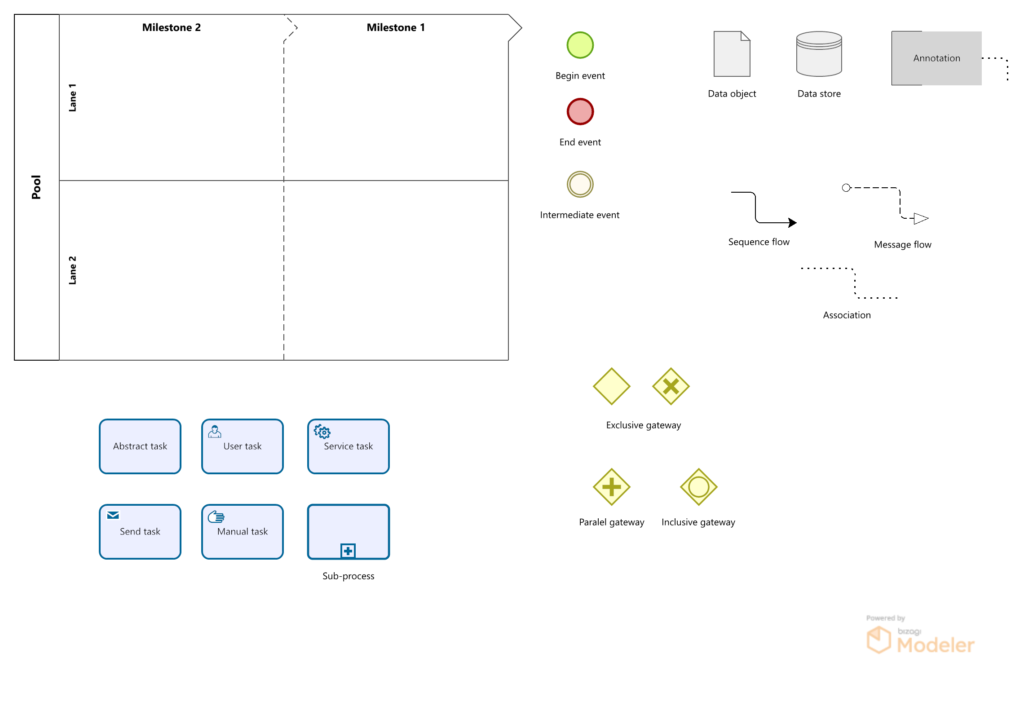
As-Is process modeling with BPMN involves documenting the current state of business processes to identify areas for improvement. Here we outline each of the essential BPMN elements commonly used in As-Is modeling, detailing their roles and how they contribute to a complete understanding of business workflows.
Events
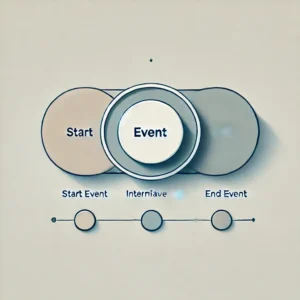
Start Event: Indicates where a process begins. It’s depicted by a plain circle and sets the stage for the process flow.
End Event: Shown as a circle with a bold border, it marks the completion of a process.
Intermediate Event: Represented by a double circle, it signifies occurrences that happen during the process, such as delays or message receptions.
Activities
Tasks
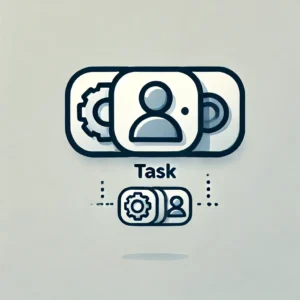
Task, The fundamental unit of work in a process, shown as a rounded rectangle.
Tasks are specific actions taken within a process. It can be a human task or service task, fundamentally.
Sub-Process
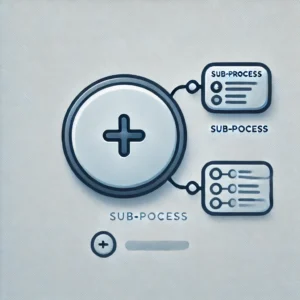
Sub-Process, encapsulated within a rounded rectangle with a plus sign, it details a series of tasks that are grouped together and can be collapsed for simplification.
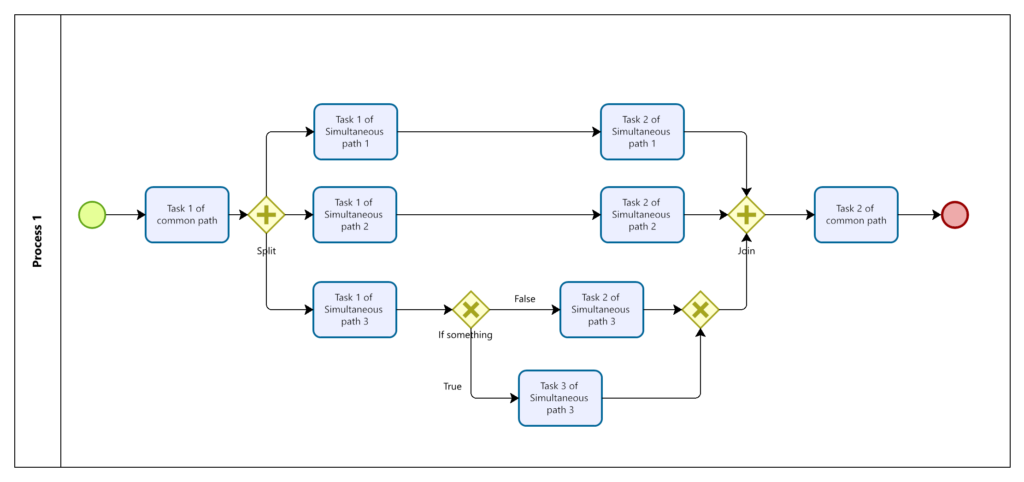
Gateways
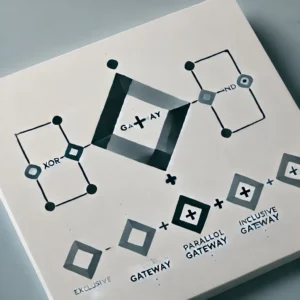
Exclusive (XOR) Gateway: Shaped like a diamond with an ‘X’, it represents decision points where two or more paths diverge based on conditions.
Parallel (AND) Gateway: A diamond with a plus sign, indicating that all outgoing paths are pursued in parallel.
Inclusive (OR) Gateway: This gateway, with a circle containing a star, allows for one or more paths to be taken, offering more flexibility than the exclusive gateway.
Event-Based Gateway: A diamond containing a pentagon, signifying that the flow will proceed based on an event rather than a condition.
Connectors
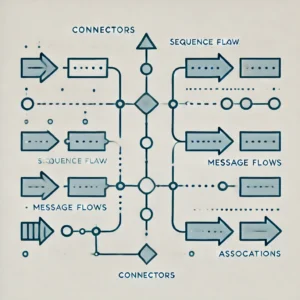
Sequence Flow: Illustrated by a solid line with an arrowhead, it shows the order of activities within the process.
Message Flow: Represented by a dashed line with a circle at one end and an arrowhead at the other, indicating the flow of messages between different organizational entities.
Association: A dotted line used to link data, artifacts, and text to activities, events, or gateways.
Pool and Lanes

Pool: A large rectangle representing a whole participant (organization or department) in the process. It can contain multiple lanes.
Lane: A subdivision within a pool indicating individual roles or departments, helping to clarify responsibilities in the process.
Artifacts
![]()
Data Object: It depicts the information flow, such as documents or reports, relevant to the process, usually represented by a rectangle with a corner folded over.
Annotation: Text annotations are linked by a dashed line to model elements, providing additional information to the reader.
Incorporating These Elements in As-Is Modeling
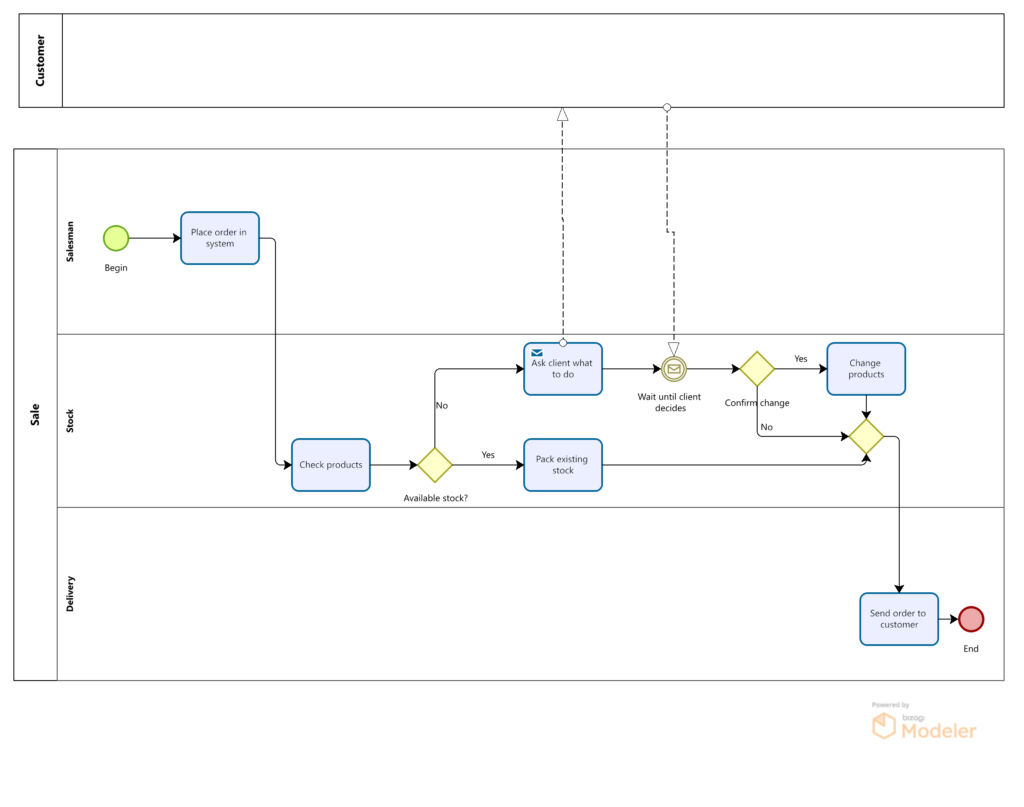
In As-Is modeling, these BPMN elements are combined to create a visual map of the current business process. The goal is to represent the workflow as it exists before any improvements or changes are made. By understanding and utilizing these elements, organizations can pinpoint inefficiencies, delays, bottlenecks, and opportunities for optimization within their existing processes.
BPMN in Action
While BPMN offers a standard set of notations, their real-world application can vary depending on the process complexity and the specific nuances of a business. These notations serve as the fundamental building blocks for modeling processes that range from the simple and linear to the complex and dynamic.
Implementing BPMN within Business Process Management Suite (BPMS) tools or Enterprise Resource Planning (ERP) systems elevates its functionality. These tools harness BPMN notations to optimize, automate, and analyze business processes, leading to more informed decision-making and strategic planning.
Conclusion: The Value of BPMN Expertise
Mastery of BPMN notations is not just about learning a new language; it’s about gaining a vantage point to view the intricate dance of processes within an organization. It’s the insight that enables managers to spot inefficiencies, envision improvements, and ultimately, drive change.
By understanding As-Is modeling through BPMN, professionals can better navigate the complexities of process management, leading to increased efficiency, cost savings, and enhanced performance.
Stepping Into BPM Mastery
For those looking to increase their BPMN skills and knowledge of the full potential of As-Is modeling, our BPM Fast Mode Courses offer a gateway to expertise. With a curriculum grounded in real-world application, you’ll be equipped to not just understand, but to transform the processes within any organization.
Unlock the power of BPMN and propel your career to new heights. Join us and become the change-maker your business seeks.




